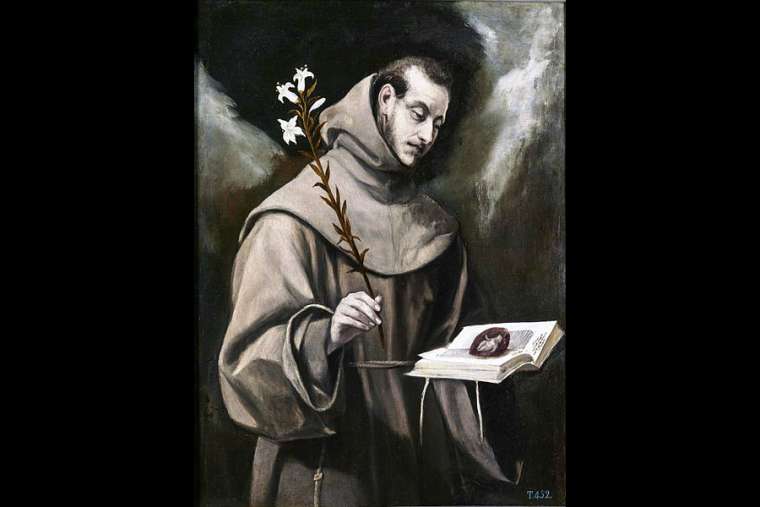St. Anthony of Padua, by El Greco (c. 1580).
Pope Francis has pointed to St. Anthony of Padua as an example for younger generations of Catholics to “live the Gospel courageously.”
“Eight hundred years ago in Coimbra, a young regular Augustinian … learned of the martyrdom of five Franciscans, killed on account of the Christian faith in Morocco on January 16 of that same year, and he decided to change his life,” Pope Francis wrote in a letter published June 3 on the Franciscan Order’s website.
“This ancient saint — so modern and brilliant in his intuitions — can be a model for the new generations to follow to make everyone’s journey fruitful,” he said.
The pope offered his apostolic blessing to the Franciscan Order of Friars Minor on the 800th anniversary of St. Anthony’s call to follow in the footsteps of St. Francis in 1220.
In a letter to Franciscan Minister General Br. Carlos Alberto Trovarelli signed Feb. 15, Pope Francis said that St. Anthony can teach everyone how to “see the Lord” in the face of each brother and sister, “offering everyone consolation, hope and the possibility of encountering the Word of God on which to anchor one’s life.”
“His example of sharing with the difficulties of families, the poor and disadvantaged, as well as his passion for truth and justice, can still arouse a generous commitment to give oneself today, in the sign of fraternity,” the pope said.
Pope Francis highlighted the saint’s spiritual journey in the footsteps of Franciscan martyrs that led him from his native Portugal to Padua, Italy.
St. Anthony of Padua was not from Padua, nor was he originally named Anthony. He was born as Ferdinand to a wealthy family in Lisbon, Portugal, in 1195.
Ferdinand entered religious life at the age of 15 in a monastery of the Augustinian Abbey of St. Vincent in Lisbon. He then moved to a more remote house in the same order to avoid distraction and concentrate on studying Scripture, while living a life of asceticism and heartfelt devotion to God.
Eight years later, in 1220, Ferdinand learned the news about five Franciscan friars who had recently died for their faith in Morocco. When their bodies were brought to Portugal for veneration, Ferdinand developed a passionate desire to imitate their commitment to the Gospel. He told a group of Franciscans who visited his monastery that he wanted to adopt their poor and humble way of life.
Some of the Augustinian monks criticized and mocked Ferdinand’s interest in the Franciscans, which had been established only recently, in 1209. But prayer confirmed his desire to follow the example of St. Francis, who was still living at the time.
He eventually obtained permission to leave the Augustinians and join a small Franciscan monastery in 1221. At that time he took the name, Anthony, after the fourth-century desert monk St. Anthony of Egypt.
Anthony wanted to imitate the Franciscan martyrs who had died trying to convert the Muslims of Morocco. He travelled on a ship to Africa for this purpose, but became seriously ill and could not carry out his intention. The ship that was supposed to take him to Spain for treatment was blown off course, and he ended up in Sicily.
“He left his homeland and set out on a journey, a symbol of his own spiritual journey of conversion,” Pope Francis said. “At first he went to Morocco, determined to live the Gospel courageously in the footsteps of the martyred Franciscan martyrs, then he landed in Sicily following the shipwreck on the coasts of Italy, as happens today to many of our brothers and sisters.”
“From the land of Sicily, God’s providential plan pushed him to meet the figure of St. Francis of Assisi on the roads of Italy and France,” the pope added.
Despite his poor health, Anthony resolved to stay in Italy in order to be closer to St. Francis himself. He concealed his deep knowledge of theology and Scripture and offered to serve in the kitchen among the Franciscan brothers.
When Anthony delivered an improvised speech before an assembly of Dominicans and Franciscans, his eloquence stunned the crowd, and St. Francis himself soon learned what kind of man the dishwashing priest really was.
In 1224 Francis gave Anthony permission to teach theology in the Franciscan order. Anthony taught theology in several French and Italian cities, while strictly following his Franciscan vows and preaching regularly to the people.
Later, he dedicated himself entirely to the work of preaching as a missionary in France, Italy and Spain, teaching an authentic love for God to many people — whether peasants or princes — who had fallen away from Catholic faith and morality.
Known for his bold preaching and austere lifestyle, Anthony also had a reputation as a worker of miracles, which often came about in the course of his disputes with heretics.
St. Anthony died in a Franciscan monastery in Padua at the age of 36 on June 13, 1231. Pope Gregory IX canonized him a year after his death.
The feast of St. Anthony is celebrated June 13 with much festivity each year in Italy and in his native Portugal.
“I hope that this significant anniversary will arouse, especially in Franciscan religious and devotees of St. Anthony scattered all over the world, the desire to experience the same holy concern that led him on the roads of the world to testify, with word and deeds, to the love of God,” Pope Francis said.

